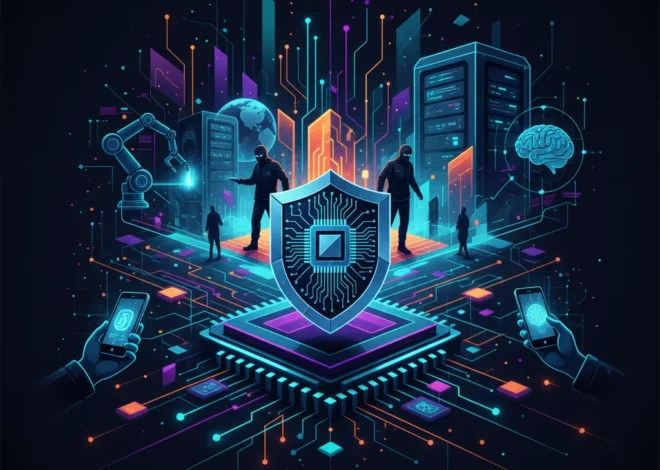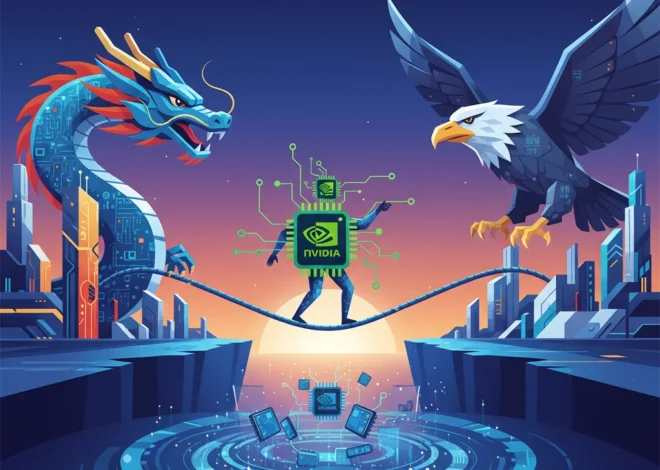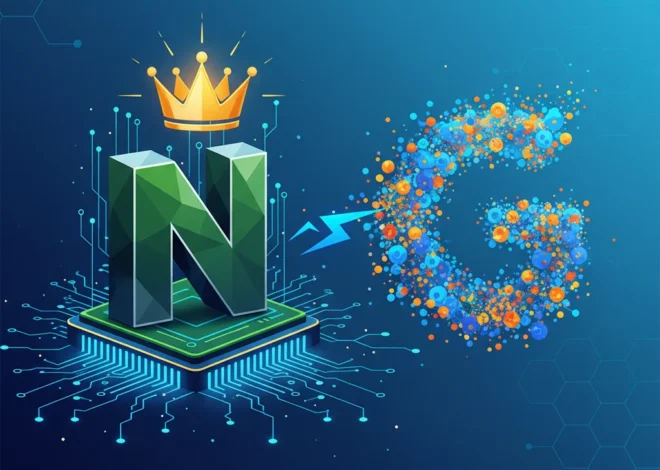
The Chip War’s New Frontline: Why a Dutch Factory Crisis Threatens Your Entire Tech Stack
In the grand theater of technology, we often focus on the dazzling stars of the show: the latest artificial intelligence models, the seamless elegance of a new SaaS platform, or the revolutionary power of cloud computing. But behind the curtain, the entire production relies on an army of unsung heroes—tiny, unassuming semiconductor chips. These microscopic components are the bedrock of our digital world. And right now, that bedrock is shaking.
A high-stakes drama is unfolding in the Netherlands, centered on a chipmaker named Nexperia. It’s a story involving a Chinese parent company, a US rival, and a Dutch government caught in the middle. While it might seem like a distant corporate dispute, its shockwaves are poised to ripple across the globe, potentially disrupting everything from your car’s electronics to the massive server farms that power the cloud and train the next generation of AI. This isn’t just a business story; it’s a critical warning about the growing fragility of the global tech ecosystem.
Nexperia’s Chinese owner, Wingtech, has issued a stark warning that the company faces an “existential threat” after a Dutch court authorized the seizure of its patent portfolio. This isn’t just corporate hyperbole. The move puts hundreds of jobs at risk in the Netherlands, Germany, and the UK, and it threatens to cripple a key supplier of essential, everyday chips. So, what’s really going on, and why should a developer, entrepreneur, or tech professional care?
The Anatomy of a High-Stakes Tech Tussle
To understand the gravity of the situation, we need to break down the key players and the core conflict. At its surface, this is a commercial dispute over intellectual property. But dig a little deeper, and the geopolitical fault lines become impossible to ignore.
The conflict stems from a legal battle initiated by US-based competitor Vishay Intertechnology. Vishay won a court order in the Netherlands to seize Nexperia’s patent portfolio as collateral in an ongoing dispute. For Nexperia’s parent company, Wingtech, this is a catastrophic blow. In a letter to Dutch officials, Wingtech warned that losing control of its intellectual property would paralyze its operations, making it impossible to sell products or secure financing. The potential fallout? The closure of factories and the loss of hundreds of skilled jobs across Europe.
Here’s a quick rundown of the key actors in this geopolitical chess match:
| Player | Role & Background | Stakes & Motivation |
|---|---|---|
| Nexperia | A Dutch semiconductor manufacturer specializing in essential, high-volume chips (diodes, transistors, etc.) used in automotive, industrial, and consumer electronics. A former division of NXP Semiconductors. | Survival. The patent seizure threatens its ability to operate, innovate, and sell products, potentially leading to its collapse. |
| Wingtech Technology | Nexperia’s Chinese parent company. A major smartphone assembler and tech conglomerate with ambitions to become a global semiconductor powerhouse. | Protecting its most valuable European asset. A Nexperia failure would be a massive financial and strategic blow to its global ambitions. |
| Vishay Intertechnology | A major US-based manufacturer of semiconductors and electronic components. A direct competitor to Nexperia in several markets. | Leveraging a legal victory. The patent seizure provides powerful collateral in their commercial dispute with Nexperia. |
| The Dutch Government | The host nation, trying to balance economic interests (jobs at Nexperia) with national security concerns and allegiance to US-led tech export controls. | Navigating a diplomatic minefield. They want to protect local jobs but are also under immense pressure from the US to curb China’s access to advanced technology. |
This situation is complicated by the fact that the Dutch government has already been tightening its grip on the semiconductor industry. Citing national security, they previously blocked Nexperia from acquiring a smaller Dutch chip company and have joined the US in restricting exports of advanced chipmaking equipment to China, a move that directly impacts Dutch tech giant ASML. Wingtech’s plea to Dutch officials highlights this tension, arguing that the government cannot claim to protect the chip sector for security reasons while allowing a competitor to dismantle a key local player (source).
This complex web of commercial interests and national security concerns is a perfect storm, demonstrating how quickly a corporate dispute can escalate into an international incident with far-reaching consequences for tech innovation and stability.
The AI Impostor: How to Protect Your Business From the Next Generation of Cyber Scams
The Ripple Effect: From Dutch Courtroom to Your Cloud Server
It’s tempting to dismiss the Nexperia crisis as a niche problem for the semiconductor industry. That would be a grave mistake. The chips Nexperia produces are not the glamorous, high-performance processors that power machine learning algorithms, but they are the essential, foundational components that make everything else work. They are the workhorses of the digital economy.
Think of them as the nails, screws, and wiring in a skyscraper. You don’t see them, but without them, the entire structure collapses. These components are in everything:
- Automotive: A modern car contains thousands of these basic chips, controlling everything from infotainment systems to safety features like airbags and braking.
- Consumer Electronics: Your smartphone, laptop, and smart home devices are packed with them.
- Industrial Automation: Factory robots, logistics systems, and manufacturing equipment rely on these components for basic functions.
- Cloud Infrastructure: Even the most advanced data centers need these chips for power management, signal regulation, and countless other tasks that keep servers running.
A disruption at a major supplier like Nexperia creates a bottleneck that affects everyone downstream. Here’s why it matters to you:
For Developers and Programmers: The stability of your entire hardware stack, from your development machine to the production servers in the cloud, depends on a healthy semiconductor supply chain. A shortage of these basic components can lead to manufacturing delays for servers, networking gear, and even laptops. This translates into higher hardware costs for your company, longer wait times for necessary equipment, and potentially higher prices for cloud computing services. The sophisticated software you write is ultimately constrained by the availability and cost of the hardware it runs on.
For Entrepreneurs and Startups: If you’re building a hardware product, this is a direct and immediate threat. Your bill of materials could see sudden price spikes, or you might find that a critical component is simply unavailable for months. For software-focused startups, especially in the SaaS space, the impact is indirect but just as real. The rising cost of the underlying cloud infrastructure will eventually be passed on to you, squeezing your margins. Furthermore, this level of geopolitical volatility adds a massive layer of risk that venture capitalists are becoming increasingly wary of, potentially making it harder to secure funding.
For Cybersecurity Professionals: A chaotic and fragmented supply chain is a security nightmare. When companies are forced to scramble for components from unvetted or gray-market suppliers, the risk of counterfeit or compromised hardware entering the supply chain skyrockets. Ensuring the integrity of the hardware foundation is a core tenet of cybersecurity, and geopolitical disruptions make that task infinitely more difficult.
Navigating the New Age of “Techno-Nationalism”
The Nexperia crisis is not an isolated incident. It is a symptom of a much larger trend: the rise of “techno-nationalism,” where countries view technological leadership as a core component of national security and global influence. This new paradigm is forcing a fundamental rethink of how the global tech industry operates.
So, what’s the path forward? There are no easy answers, but several key strategies are emerging:
- Supply Chain Diversification and Resilience: The era of relying on a single supplier in a single country is over. Companies are now actively pursuing “China plus one” strategies, onshoring (moving production back home), or “friend-shoring” (partnering with politically aligned nations). This is expensive and complex but is increasingly seen as a necessary cost of doing business. This shift is driving a new wave of automation and innovation in manufacturing processes to make domestic production more competitive.
- Geopolitical Risk as a Core Business Function: Tech companies can no longer afford to ignore geopolitics. Understanding the political landscape, the trade relationships, and the legal frameworks of the countries you operate in is now as critical as understanding your tech stack. This means hiring for new skill sets and integrating geopolitical analysis into strategic decision-making.
- Rethinking Intellectual Property Strategy: IP is now a key battleground. Companies must be more strategic than ever about where they file patents, how they structure licensing agreements, and how they protect their trade secrets in a world where legal systems can be used as political weapons.
For those of us building the future with software, code, and algorithms, this new reality can feel daunting. The clean, logical world of programming is colliding with the messy, unpredictable world of international relations.
The Code Red Shift: Why Silicon Valley's Titans Are Ditching Liberalism for the New Right
The Future is Forged in Silicon and Strategy
The fate of Nexperia’s European factories hangs in the balance, and the outcome will send a powerful signal about the future of global technology collaboration. But regardless of what happens, the lesson is clear: the ground beneath our feet has shifted.
The silent, intricate dance of the global supply chain has been interrupted by the loud, clashing ambitions of nations. The foundational elements of our digital world—the silicon chips in our devices—have become pawns in a great power competition. The future of innovation, from the next breakthrough in artificial intelligence to the next disruptive SaaS startup, will depend not just on brilliant ideas and elegant code, but on our ability to navigate this complex and treacherous new landscape.


